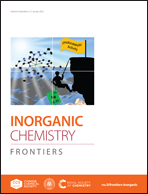CoTe2–NiTe2 heterojunction directly grown on CoNi alloy foam for efficient oxygen evolution reaction†
Abstract
The development of high-efficiency and durable non-noble metal-based oxygen evolution reaction (OER) electrocatalysts is a particularly urgent need for electrochemical water splitting. An effective electrocatalyst can be prepared by tailoring the composition, morphology, and structure of the material. Herein, we report a CoTe2–NiTe2 heterojunction directly grown on CoNi alloy foam (CNF) via a simple hydrothermal route. The optimized electrode of 3CNT/CNF-240C was achieved through the adjustment of reductant addition of N2H4·H2O and the reaction temperature in the hydrothermal reaction. The 3CNT/CNF-240C electrode only needs a low overpotential of 280 mV to attain an anodic current density of 10 mA cm−2, and shows fast kinetics for the OER with a small Tafel slop of 19.4 mV dec−1. The enhanced OER performance could be attributed to the interaction between CoTe2 and NiTe2 in the heterojunctions promoting the charge transfer process. Moreover, 3CNT/CNF-240C also shows excellent long-term stability, which can maintain 18 h of continuous electrolysis without obvious degradation. Our research provides a new strategy for the direct synthesis of integrated hybrid structured electrocatalysts to achieve highly active and durable water splitting.



 Please wait while we load your content...
Please wait while we load your content...